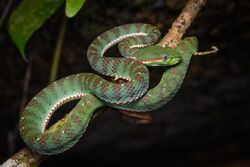Biology:Trimeresurus sabahi
| Trimeresurus sabahi | |
|---|---|

| |
| Trimeresurus sabahi fucatus | |
| Scientific classification | |
| Domain: | Eukaryota |
| Kingdom: | Animalia |
| Phylum: | Chordata |
| Class: | Reptilia |
| Order: | Squamata |
| Suborder: | Serpentes |
| Family: | Viperidae |
| Genus: | Trimeresurus |
| Species: | T. sabahi
|
| Binomial name | |
| Trimeresurus sabahi Regenass & Kramer, 1981
| |
| Synonyms | |
| |
Trimeresurus sabahi, commonly known as the Sabah pit viper[1] or Sabah bamboo pitviper,[3][4] is a venomous pitviper species.[3] If defined narrowly, it is endemic to the island of Borneo.[1] If defined more broadly, it consists of five subspecies found in Southeast Asia.[3]
Subspecies
There are five subspecies:[3]
- Trimeresurus sabahi barati Regenass & Kramer, 1981 – Sumatra, Mentawai Archipelago (Indonesia)
- Trimeresurus sabahi buniana Grismer, Grismer & McGuire, 2006 – Tioman Island (Malaysia)
- Trimeresurus sabahi fucatus Vogel, David & Pauwels, 2004 – Malay Peninsula (southern Myanmar, Thailand, West Malaysia)
- Trimeresurus sabahi sabahi Regenass & Kramer, 1981 – northern Borneo (Malaysia)
- Trimeresurus sabahi toba David, Petri, Vogel & Doria, 2009 – Sumatra
IUCN treats these as full species, respectively Trimeresurus barati,[5] Trimeresurus buniana,[6] Trimeresurus fucatus,[7] and Trimeresurus toba,[8] restricting Trimeresurus sabahi to the nominotypical subspecies.[1]
Description
Adults may attain a snout-vent length (SVL) of 62 cm (24 in).[9]
Dorsally, it is uniform green, without crossbars. Ventrally it is pale green. There is narrow bicolor stripe on the first one and a half dorsal scale rows. In males this stripe is rust-colored or red below, and it is white above. In females it is yellow or white. The iris of the eye is red or orange in adults of both sexes, but in young specimens may be yellowish-green. There are no markings behind the eye.[9]
The scalation includes 21 (23) rows of dorsal scales at midbody, 149–157/148–156 ventral scales in males/females or 148–159 in general, 72–76/59–65 subcaudal scales in males/females, and 9–11 supralabial scales (9–10 with the third being the largest).[4]
Habitat
In Borneo, it inhabits mountainous regions at altitudes from 1,000 m (3,300 ft) to 1,150 m (3,770 ft), where it is commonly found on branches of shrubs and other low vegetation.[9]
Reproduction
The reproductive biology of this species is unknown.[9]
References
- ↑ 1.0 1.1 1.2 1.3 Iskandar, D.; Das, I.; Inger, R.F.; Vogel, G.; Dehling, M. (2022). "Trimeresurus sabahi". IUCN Red List of Threatened Species 2022: e.T192042A217766870. doi:10.2305/IUCN.UK.2022-1.RLTS.T192042A217766870.en. https://www.iucnredlist.org/species/192042/217766870. Retrieved 19 September 2022.
- ↑ McDiarmid RW, Campbell JA, Touré T. 1999. Snake Species of the World: A Taxonomic and Geographic Reference, Volume 1. Herpetologists' League. 511 pp. ISBN:1-893777-00-6 (series). ISBN:1-893777-01-4 (volume).
- ↑ 3.0 3.1 3.2 3.3 Trimeresurus sabahi at the Reptarium.cz Reptile Database. Accessed 19 September 2022.
- ↑ 4.0 4.1 Gumprecht A, Tillack F, Orlov NL, Captain A, Ryabov S. 2004. Asian Pitvipers. Geitje Books. Berlin. 1st Edition. 368 pp. ISBN:3-937975-00-4.
- ↑ Iskandar, D.; Vogel, G.; Inger, R.F.; Auliya, M. (2022). "Trimeresurus barati". IUCN Red List of Threatened Species 2022: e.T191923A217765960. doi:10.2305/IUCN.UK.2022-1.RLTS.T191923A217765960.en. https://www.iucnredlist.org/species/191923/217765960. Retrieved 18 September 2022.
- ↑ Grismer, L. (2022). "Trimeresurus buniana". IUCN Red List of Threatened Species 2022: e.T192086A217767279. doi:10.2305/IUCN.UK.2022-1.RLTS.T192086A217767279.en. https://www.iucnredlist.org/species/192086/217767279. Retrieved 19 September 2022.
- ↑ Wogan, G.; Vogel, G.; Pauwels, O.S.G. (2012). "Trimeresurus fucatus". IUCN Red List of Threatened Species 2012: e.T178659A1541045. doi:10.2305/IUCN.UK.2012-1.RLTS.T178659A1541045.en. https://www.iucnredlist.org/species/178659/1541045. Retrieved 19 September 2022.
- ↑ Iskandar, D.; Vogel, G.; Inger, R.F. (2022). "Trimeresurus toba". IUCN Red List of Threatened Species 2022: e.T193452A217770501. doi:10.2305/IUCN.UK.2022-1.RLTS.T193452A217770501.en. https://www.iucnredlist.org/species/193452/217770501. Retrieved 19 September 2022.
- ↑ 9.0 9.1 9.2 9.3 Das, Indraneil. A Photographic Guide to Snakes and Other Reptiles of Borneo. Ralph Curtis Books. Sanibel Island, Florida. 144 pp. ISBN:0-88359-061-1. (Popeia sabahi, p. 56.)
Further reading
- Regenass, Urs; Kramer, Eugen. 1981. Zur Systematik der grünen Grubenottern der Gattung Trimeresurus (Serpentes, Crotalidae). Rev. Suisse de Zoolo. 88 (1): 163–205.
Wikidata ☰ Q3539225 entry
 |



